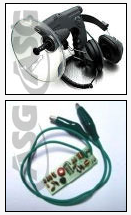Signs of Being “Bugged”
-
People seem to know your activities when they shouldn’t

-
Others know your confidential business or professional trade secrets
This is the most obvious indicator of covert eavesdropping activities. Theft of confidential information is a multi-billion dollar underground industry in the United States. Often the loss of your secrets will show up in very subtle ways so you should always trust your instincts in this matter. When your competitors know things that are obviously private, or the media is privy to information they should not know, then it is reasonable to suspect technical eavesdropping or bugging.
If You Believe Your Office or Home is Bugged, Call Us Immediately at 888-677-9700
-
Secret meetings and bids seem to be less than secret
Confidential meetings and bids are very popular targets for corporate spies. How would you like the plans for the corporate takeovers you’re planning to become public knowledge? Would copies of your product designs be of any use to your competitors? Would it be beneficial for your competitors to know how much you’re quoting for the same project?
-
Unusual sounds or volume changes on your phone lines
This is commonly caused by an amateur eavesdropper when they attach a wiretap, or activate a similar listening device. Surveillance devices often cause slight anomalies on the telephone line, such a volume shift or drop-out. Professional eavesdroppers and their equipment usually do not make such noises; so if this is going on, it could indicate that an amateur eavesdropper is listening in.
-
Static, popping, or scratching sounds on your phone lines
This is caused by the capacitive discharge which occurs when two conductors are connected together (such as a bug or wiretap on a phone line). This is also a sign that an amateur eavesdropper or poorly trained spy is playing with your phone lines. It could be nothing more then a problem with your phone line or instrument, but a TSCM person should evaluate the situation to make sure.
-
Sounds coming from your phone’s handset when it is hung-up
This is often caused by a hook switch bypass, which turns the telephone receiver into an eavesdropping microphone (and also a speaker). There is probably somebody listening to everything you say or do within twenty feet of the telephone (if this is happening).
-
Your phone often rings and nobody is there, or a very faint tone, or high pitched squeal/beep is heard for a fraction of a second
This is an indicator of a slave device, or line extender being used on your phone line. This is also a key indicator of a harmonica bug, or infinity transmitter being used. Of course it may also be nothing more then a fax machine or modem calling the wrong number (but a TSCM person should evaluate the situation to make sure).
-
Your radio suddenly encounters some type of interference
Many amateur and spy shop eavesdropping devices use frequencies within or just outside the FM radio band. These signals tend to drift and will “quiet” an FM radio in the vicinity of the bug. Look for the transmissions at far ends of the FM radio band, and at any quiet area within the FM band. If the radio begins to squeal, then slowly move it around the room until the sound become very high pitched. This is referred to as feedback detection, or loop detection and will often locate the bug. The “stereo” function should be turned off so the radio is operating in “mono” as this will provide a serious increase in sensitivity. If you find a “squealer” in this manner then immediately contact a TSCM and get them to your location FAST.
-
You car radio suddenly encounters some type of interference
Keep in mind that the antenna your car radio uses may be (and often is) exploited by an eavesdropper, and that such usage may interfere with radio.
-
Your television has suddenly developed strange interference
Television broadcast frequencies are often used to cloak a eavesdropping signal, but such a devices also tends to interfere with television reception (usually a UHF channel). Televisions also “suck in” a lot of RF energy and because of this are very sensitive to any nearby transmitters (this is technically called “Bandwidth, and TV signals use a lot of it). A small handheld television with a collapsible antenna may be used to sweep a room. Carefully watch for interference around channel numbers 2, 7, 13, 14, 50-60, and 66-68 as these frequencies are very popular with eavesdroppers.
-
You have been the victim of a burglary, but nothing was taken
Professional eavesdroppers often break into a target’s home or office and very rarely leave direct evidence of the break-in; however, occupants of the premises will often “pickup on something not being right” such as the furniture being moved slightly.
-
Electrical wall plates appear to have been moved slightly or the paint on the screws is chipped
One of the most popular locations to hide eavesdropping devices is inside or behind electrical outlets, switches, smoke alarms, and lighting fixtures. This requires that the wall plates be removed. Look for small amounts of debris located on the floor directly below the electrical outlet. Also, watch for slight variations in the color or appearance of the power outlets and/or light switches as these are often swapped out by an eavesdropper. Also note if any of the screws which hold the wall plate against the wall have been moved from their previous position.
-
A dime-sized discoloration has suddenly appeared on the wall or ceiling
This is a tell-tale sign that a pinhole microphone or small covert video camera has been recently installed.
-
Certain types of items have “just appeared” in your office or home, but nobody seems to know how they got there
Typical items to watch for and beware of are: clocks, exit signs, sprinkler heads, radios, picture frames, and lamps.
-
White dry-wall dust or debris is noticed on the floor next to the wall
This is a sign that a pinhole microphone or video camera may have been installed nearby. It will appear as if someone has dropped a small amount of powdered sugar either on the floor or on the wall.
-
You notice small pieces of ceiling tiles, or “grit” on the floor, or on the surface area of your desk
Prime indicator that a ceiling tile has been moved and that someone may have installed a hidden video camera or other eavesdropping device in your office or near your desk. Also watch for cracks or chips in the ceiling tiles. Amateur and poorly trained spies tend to crack or damage acoustical tiles. The ceiling tiles in any executive areas should never contain any cracks, nicks, gouges, or stains. Any ceiling tile that becomes damaged (for what ever reason) should immediately be replaced and the cause to the damage documented. In such cases, it is also wise to have a TSCM specialist inspect the area around the chipped, broken, or damaged tile to determine if a hostile eavesdropping device may have been introduced.
-
You notice that “Phone Company” trucks and utilities workers are spending a lot of time near your home or office doing repair work
If you see the same (or similar) vehicles more then three times in a relatively short period of time, then you may have a serious problem. This is according to the U.S. State Department training course on counter surveillance.
-
Telephone, cable, plumbing, or air conditioning repair people show up to do work when no one called them
A very common ruse which eavesdroppers use to get into a facility is to fake a utility outage and then show up to fix the problem. While they are fixing “the problem” they are also installing eavesdropping devices. Some of the more popular outages involve power, air conditioning, telephone, and even the occasional false fire alarm.
-
Service or delivery trucks are often parked nearby with nobody visible in them
These vehicles are commonly used as listening posts. Be very cautious of any vehicle which has a ladder or pipe rack on the roof. Also, be wary of any vehicle which has tinted windows, or an area which you cannot see though (like a service van). The listening post vehicle could be any vehicle from a small Geo Tracker, Suburban, Blazer, Trooper, or Cargo Van. Look for any vehicle which could conceal a person in the back or has tinted windows. Also, keep in mind that the eavesdropper may relocate the vehicle several times, so look around. Typically, eavesdroppers like to get within 500-750 feet from the place or person they are eavesdropping on.
-
Things “seem” to have been rummaged through, but nothing is missing (at least that you noticed)
A “less than professional spy” will often rummage through a target’s home for hours, but very rarely will they do it in a neat and orderly fashion. The most common “rummaging” targets are the backs of desk drawers, the bottom of file cabinets, closets, and dresser drawers.
Recent Blog Posts
Private investigators, often portrayed in popular culture as mysterious figures with an array of skills, play a crucial role in uncovering information, solving mysteries, and … Read more
The journey towards justice is complex and varied within the realm of defense. In Michigan, where justice is deeply valued criminal defense investigators play a … Read more
Corporate internal investigations are a critical facet of maintaining transparency, integrity, and compliance within organizations. Whether triggered by suspicions of misconduct, regulatory requirements, or a … Read more
Whether you’re a seasoned entrepreneur or just starting out, understanding and managing business assets in Michigan is the first step towards building a thriving business … Read more




